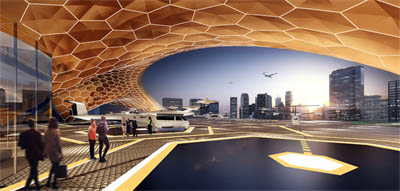In October, Uber Elevate reaffirmed that North Texans likely will see its vertical takeoff air taxis cruising the skies over Dallas-Fort Worth by 2023. Advanced military aircraft and helicopters will continue to roll off North Texas assembly lines. And, millions of passengers will fly on Dallas-Fort Worth-based airlines to locales in the U.S. and across the globe.
All of those are signs that the aviation and aerospace industries in North Texas—some 900 companies strong—are continuing to grow and innovate. North Texas cities benefit from the corporations and businesses that call the region home, bringing with them tens of thousands of jobs, new residents, and a thriving economy.
From fighter jets and giant commercial airliners to luxurious corporate aircraft and technologically advanced helicopters and air taxis, Dallas-Fort Worth is at the forefront of the aviation industry.
Aviation is a driving force of the North Texas economy, credited with helping attract Fortune 500 companies, high-tech startups, and massive logistics hubs. By most accounts, aviation is a linchpin in the region’s booming real estate sector and a driving force behind high-tech manufacturing and research.
Dallas Fort Worth International Airport alone pumps an estimated $37 billion into the local economy each year. Add in Dallas Love Field, Fort Worth Alliance Airport, a network of roughly 20 municipal and corporate airports, and some of the biggest aerospace manufacturers in the world, and it’s easy to see how aviation is in the captain’s seat of the region’s economic well-being.
“DFW grew up on aerospace. A lot of people don’t realize that,” Hillwood Executive Vice President Bill Burton says. “For many years, we had the third largest aviation employment base in the country. To us, it’s really not surprising that this would be a place where you see innovation in aerospace because it’s part of the history and evolution of aerospace.”
When the word aviation is attached to Dallas-Fort Worth, it conjures up a lot of famous names. Think American Airlines, Southwest Airlines, Lockheed Martin, Bell Helicopter, Airbus, Rolls Royce, and Boeing, to name a few.
From the F-35 Lightning II assembly line in Fort Worth to Uber Elevate’s plans for an on-demand air taxi network connecting Dallas Fort Worth International Airport to Frisco and downtown Dallas, North Texas continues to be on the cutting edge of aviation innovation. Here are the stories behind some of the industry’s biggest names.
Airports helped North Texas take off
Dallas Fort Worth International Airport opened for commercial flights in January 1974 at a cost of roughly $700 million. The previous September, an open house and dedication ceremony was held featuring the first landing of a supersonic Concorde airliner in the United States and an Air France aircraft en route from Venezuela to Paris.
Since its opening, DFW Airport has grown into the fourth-busiest airport in North America by number of passengers. It is the largest hub of Fort Worth-based American Airlines, which has flown out of the airport from its first days. Today, more than 80 airlines and freight carriers operate from the airport, bringing people and commerce into North Texas.
Like Kubota Tractor Corp. in Grapevine, many companies have located their headquarters, logistics, and fulfillment operations near DFW Airport, which covers 17,207 acres and is larger than the island of Manhattan. It’s the second-largest airport in the United States by land area.
As big as it is, DFW Airport is still growing—planning to build a sixth terminal (Terminal F) and renovate Terminal C to the tune of $3 to $3.5 billion by 2025. Airport CEO Sean Donohue said the new terminal will add up to 24 more gates at DFW.
At the expansion announcement in May, then-Dallas Mayor Mike Rawlings lauded American Airlines’ support for the airport’s growth because it is good for North Texas.
“To have a partner like American Airlines that believes in this region—that believes in this airport—says that the growth cycle of this town is going to continue to grow,” Rawlings said.
